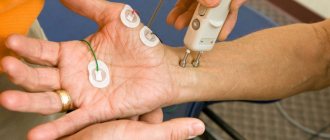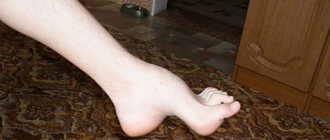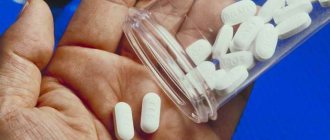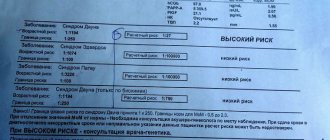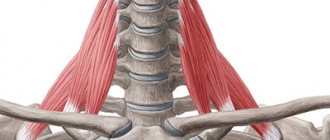In the practice of a psychiatrist, almost everything happens: intriguing, funny, sad, annoying. Over time, you get used to different forms of madness. But there are things that are impossible to get used to. Even we, psychiatrists, have an irrational fear of the incomprehensible, a fear of unnatural acts that violate the foundations of the existence of living things.
I'm talking now about deliberate self-harm or deliberately causing suffering to loved ones. And it’s especially scary when this is done by a person who is considered normal in all other respects.
Cut me completely
A simple example from practice.
A couple of years ago I was invited to a consultation in the surgical department. I was introduced to a mournful middle-aged man. The patient held his stomach and moaned deliberately, swaying like a metronome. There were tears in my eyes. - I beg you... It hurts me... If I die, it will be worse for you... The surgeons smiled: - Maybe you can be patient? Medicines will help, no need to cut! The patient ignored the entreaties. Gradually he turned to threats; the sadness on her face gave way to a grimace of anger. — I have a direct phone number for the Ministry of Health! You already had problems!.. The surgeons continued to smile. This was not the first time they saw the patient and performed diagnostic operations on him twice during the year. “Sick” was not sick at all. He turned out to be not a surgical patient, but a psychiatric patient diagnosed with Munchausen syndrome.
In this situation, it was not his life that needed to be saved, but rather the nerves, time and health of the doctors. All I had to do was objectively record the patient’s mental state and provide a conclusion - in order to protect my colleagues from the brewing conflict. It is useless to dissuade a patient with Munchausen syndrome. He doesn't strive to be healthy. He needs surgery, he wants to be cut open. It sounds crazy, but that’s the essence of the problem. And the patient doesn’t care that the doctor’s job is not cutting, but treating people. He is confident that the operation will help, and actively feigns pain and malaise, resorts to tricks and threats - just to get his way.
The “patient” understood this and did not want to talk to the psychiatrist; he clearly already had such experience. After much persuasion and explanations that they would not operate on him anyway without my examination, the man made contact. He assured me that he had a “surgical pathology,” sprinkled in medical terms, and listed numerous “symptoms.” And the surgeons and I clearly understood: the symptoms that our client describes are mutually incompatible. This man has clearly read the medical literature, but in some things only a doctor is competent; experience cannot be replaced by teaching. As a result, our “sufferer” was discharged after a commission examination, with a recommendation for treatment by a psychiatrist. Although it is unlikely that he went to him. Such people rarely come to us on their own. They are encountered mainly by surgeons, less often by therapists. Psychiatrists are the enemy for people with this disorder. The story I just told is quite ordinary. The worst is yet to come. But first, I will dwell in more detail on what “Munchausen syndrome” is.
The basic unit of general psychopathology is the syndrome [1–4]. There are psychopathological syndromes that occur frequently, and they are constantly heard, but there are many that are relatively rare. Such rare (or rather, rarely diagnosed) psychopathological formations include a syndrome that in German psychiatry is called “Anwesenheit” - “embodied presence”. In French-language literature, such an experience has been given the name “Sentiment de presence” [5], which actually means the same thing and can be translated as a feeling of presence. In English-language literature, this phenomenon is called False Proximate Awareness (FPA) - false express awareness. This phenomenon is known to be referred to as “personified awareness.” We will use the term “embodied presence syndrome” (EPS).
Description, history and modernity
SVP is characterized by an erroneous sensation of the presence of a foreign being in the immediate vicinity of the patient, with clear consciousness, when the patient is alone at home or in another room. Less often, such a feeling occurs in open space. At the same time, the patient feels the presence of another unfamiliar person or creature, which is not perceived either by hearing or by sight [6].
SVP differs from true hallucinations in the absence of the fact of perception without an object. What distinguishes the symptoms of SVP from delusional experiences is the lack of confidence in this experience [7]. The phenomenon of SVP, meaning the presence of some object or being, does not indicate its origin or additional characteristics of the object of experience. The essence of this phenomenon cannot be reduced to sensory deception, since the sensory element is absent [6]. It does not boil down to a delusional idea, since the patient’s real experience is aimed at searching for assessment and evidence, which can be both correct and delusional [8].
The first description of SVP most likely belongs to the American philosopher and psychologist W. James [9], who wrote: “I was still thinking about the events of the last night, when I felt something enter the room and come close to my bed. This lasted only 1-2 minutes. I understood this not with my feelings, nevertheless, more than any other sensation, it stirred the very depths of my soul. In any case, there was something near me, and I felt its presence more clearly than I had ever felt the presence of any creature of blood and flesh.
One of the most detailed descriptions of the “Anwesenheit” phenomenon can be found in “General Psychopathology” by K. Jaspers [6]: “We are talking about the phenomenon of false awareness of a physical presence. The patient felt that someone was constantly following him, or rather, slightly behind and to the side of him. When the patient got up, this “someone” also got up; when he walked, “someone” walked with him; when he turned around, “someone” was standing behind him so that he could not be seen. He was always at the same distance, although sometimes he moved slightly closer or slightly further away. The patient had never seen him, heard him, touched him, or felt his touch; nevertheless, he experienced with exceptional clarity the feeling of someone's physical presence. Despite the severity of the experience, the patient ultimately concluded that there was no one behind him.” Describing the phenomenon of embodied presence, the author emphasizes its absolute primacy, “...possessing signs of urgency, certainty and concrete embodiment.”
It should also be noted that, along with the “sense of presence” itself, visual hallucinoids and haptic hallucinations can occur in the structure of the SVP [10].
In modern general psychopathology, the term “hallucinoids” is absent. V.Kh. Kandinsky [11] considered “hallucinoids” as a supposed synonym for pseudohallucinations, E.A. Popov [12] called “hallucinoids” psychopathological phenomena intermediate between normal ideas and hallucinations, which are incomplete, imperfect hallucinations. N.N. Korganov [13] considered “hallucinoids” to be incomplete hallucinations, which are distinguished by three characteristics: alienation from the patient’s personality, lack of extraprojection and a sense of reality of the hallucinatory image, and G.K. Ushakov [14] referred to visual hallucinations that occur during the day without connection with sleep, but with eyes closed, observed in somatogenic asthenia.
Due to the lack of a generally accepted definition of V.V. Kalinin [10] considered it correct to include in the term “hallucinoids” the content proposed by M.I. Rybalsky [15]: “hallucinoids are incomplete pseudohallucinations, i.e. phenomena intermediate between true and pseudohallucinations, arising with an unclouded consciousness. They are characterized by extraprojection, the presence of an intimate connection with the pathology of thinking, unclear dependence on receptor organs, lability and staticity within the hallucinatory image. Hallucinoids are deprived of a natural external design, do not have a clear localization in space, are perceived by patients as something fleeting, indistinct, unclear: a shadow, a ghost passing before the eyes, an image, a figure visible not far from the eyes and disappearing when trying to look closely.”
The described visual images are localized not in the center of the visual field, but on its periphery, therefore, in relation to them, we can talk about extracampal hallucinations, since patients claim that they see images with peripheral vision or even beyond it [7]. It is important that such visual illusions disappear if the patient attempts to peer into the images, which distinguishes them from hallucinatory phenomena in delirium. It indirectly follows from this that their origin is based on a certain hypotension of mental processes, while activation of mental activity leads to their elimination [10].
Haptic hallucinations constitute the third component of the presence syndrome. This term is used to characterize the complex deception of tactile and general senses in the form of sensations of grasping, touching, touching [15]. Patients in these cases preferred to talk more often about the breeze, the blow.
The main characteristic of all three components of SVP, according to V.V. Kalinin [10], is the rudimentary and incompleteness of experiences.
The connection between the above three manifestations of SVP was studied by V.A. Soldatkin [16]. The author conducted an anonymous survey of 480 medical students who did not seek medical help. The age of the respondents ranged from 17 to 39 years (average age 19.9 years). 124 (25.8%) boys and 356 (74.2%) girls took part in the event. The questionnaire included an item assessing the experience of “embodied presence.” It was suggested to mark the point if at least once in your life: 1) it seemed that someone invisible was present next to you. You did not see or hear this person present, and yet there was a feeling that you were not alone in the room (although in fact there was no one). 191 (39.8%) respondents answered positively; 2) with peripheral vision (in the corners of the eyes) you saw fleeting fuzzy shadows, or silhouettes, or figures with unclear outlines. If you tried to see them, they disappeared. 164 (34.2%) students gave a positive answer; 3) at the same time, a sensation of grasping, touching, touching, blowing appeared - for seconds. Positive answers - 83 (17.3%). The study showed that SVP is not a rare phenomenon. The relationship between the parameters of interest was assessed using the method of nonparametric statistics (Spearman's rank correlation). The manifestations of SVP turned out to be significantly related to each other. The association between the three components of the syndrome was of moderate strength; presence was somewhat more associated with haptic than with extracampal visual hallucinations. The presence of a reliable connection between the sense of presence, haptic and extracampal visual hallucinations allowed us to assume their pathogenetic commonality. It has been established that there are significant ( p
≤0.05) correlations between the experience of a sense of presence and female gender (
r
=0.14) [16].
Prevalence
To study the prevalence of SVP among various categories of the population, in most cases, Internet questionnaires are used. One of the main advantages of such a tool is its complete anonymity. Online questionnaires also allow respondents to participate without direct interaction with the researcher. At the same time, there is a distinct drawback of the method in the form of the impossibility of differential diagnosis with conditions similar to SVP.
The prevalence of “felt presence” in the literature is presented by the following figures: 43% [17]; 60% [18]; 28.4% [19]; 67.8% [20]; 34% [21]; 39.6% [22, 23]. The discrepancies in the data may be due to different strategies for recruiting participants in online surveys. The conclusion from all the studies conducted is that the experience of “felt presence” is widespread among the general population. However, it is possible that these figures are inflated due to the combination of SVP with similar conditions.
Conditions similar to SVP
Let us present a number of descriptions that are outwardly similar to SVP states, which, in our opinion, have only an indirect affinity with the phenomenon under consideration (Table 1 shows
Signs of similarities and differences similar to SVP states).
W. James [9], K. Jaspers [6], T. Luhrmann [24], R. Morgain [25] described among members of prayer groups the experience of the “close tangible presence” of a spiritual being (God, angel, spirit guide, devil or demon), and in the ethnographic work of T. Luhrmann [25], it was also noted that this feeling is an important component of evangelical religious practice. The role of corresponding physiological states in “life quests”, common in many traditional religious practices, which specifically induce the felt experience of presence, is also known [26].
Some authors [27] described the phenomenon, occurring in the postpartum state in women, of the presence of a baby on the bed next to the mother ( English
.: Baby-in-bed, BIB) as an analogue of “Anwesenheit”. The Baby-in-bed phenomenon refers to parasomnias with nightmares and challenging behavior in which the mother searches for the baby and cannot find it. This feeling is often accompanied by excitement, crying in sleep, and sleep-talking. During awakening, when the mother is fully awake and realizes that the baby was not in the bed and that it was just a dream, she nevertheless often gets up to check that the baby is safe.
In children, a state similar to embodied presence is described as a phenomenon called “children's imaginary companion” [28]. The “companion” appears in children’s fantasies, is often given a name, the child talks to him and receives messages from him. The child can calmly smile at his own fantasies, give them shape, or behave in accordance with the advice of the “companion.” In most cases, children's imaginary companion appears between 3 and 6 years of age and then disappears. This phenomenon is endowed with all subjective (active search, partially preserved criticality, the ability to cause and eliminate the phenomenon at will), as well as sensory properties (acoustic and visual expression).
Conditions resembling SVP can occur after bereavement [29, 30]. A phenomenon close to SVP often occurs in cases of widowhood and represents the feeling of having a deceased loved one nearby. The appearance of the phenomenon is preceded by a more or less long period of monoideism, focused exclusively on the image of the deceased, on his physical and psychological characteristics [29]. S. Parkes [30] considers the described phenomenon as a temporary form of “softening”, a transitional stage from a feeling of physical closeness to a feeling of psychological closeness with the deceased, which some authors [31] present as a model of overcoming loss.
A condition with signs of SVP has been described by some researchers [19] and in the structure of a complex condition called “sleep paralysis,” which refers to parasomnias. The feeling of the presence of a stranger in “sleep paralysis” can occur in isolation, in the absence of visual, auditory or tactile hallucinations, and is the most common phenomenon (up to 80% of all episodes) [19]. The condition is usually accompanied by strong emotions and is usually associated with fear and anxiety [32]. In more extreme cases, the felt presence may take the form of an attack with accompanying fictitious feelings of being strangled, beaten, or even raped [20, 33].
A state similar to SVP was also noted in the structure of an epileptic attack - as a component of the epileptic aura [34]. There are observations of the SVP phenomenon in patients suffering from temporal lobe epilepsy [35].
In the literature, we can find a description of a phenomenon reminiscent of SEP, which occurs with direct stimulation of the brain with electricity [36] and with stimulation with weak magnetic fields [37, 38].
A number of authors [39, 40] describe conditions similar to the phenomenon of SVP, arising from partial sensory deprivation. It seems to us that such psychopathological states are closer not to SVP, but to psychogenic paranoids, the so-called allers-paranoids [41, 42]. The mechanisms of occurrence of delusions of the hard of hearing are similar to paranoids associated with mental isolation. All these conditions cannot be attributed to SVP due to the presence of delusions and lack of criticism.
There are clinical descriptions of conditions similar to SVP in trauma and brain tumors [43], as well as in Parkinson’s disease [44, 45]. A phenomenon reminiscent of SVP is also observed during intoxication or overdose of drugs with direct dopaminergic and serotonergic effects (for example, dopamine derivatives) [7].
Fiction also did not escape Anwesenheit. We find the most detailed descriptions of states similar to SVP in Guy de Maupassant’s story “Orlya” [46], in J. Conrad’s story “The Secret Accomplice” [47], in A. Strindberg’s novel “Inferno” [48] and in other works.
Analyzing the above descriptions using clear criteria described by K. Jaspers [6], it can be argued that they have only an external resemblance to SVP. The table below summarizes these conditions in terms of their similarities and differences from SVP.
It should be noted that the above conditions can only be distinguished by a clinical method. There is no psychometric scale to identify the experience of SVP. In foreign literature, there is evidence of attempts to use the following instruments in the study of SVP: “Other Experience Questionnaire OEQ7” [32], “Index of Basic Spiritual Experience INSPIRIT” questionnaire [53], A. Tellegen Absorption Scale [54], Magic Idea Scale [55 ] and the Cardiff Anomalous Perception Scale [56]. But the listed scales did not give the desired results. The Sensed Presence Questionnaire (SenPQ) is positioned by the authors as the first valid and reliable instrument capable of psychometrically identifying the “sense of presence” [57], but the experience of its use is not presented in the available literature.
Concepts of the origin of SVP
SVP can be attributed to those phenomena that are designated as “predecessors” [58], “remote prodromes” [59], “lightning flashes” [60], psychopathological “episodes” [61], outpost syndromes [62], early and very early “precursors” [63], early dysfunctional states [64], prodromal type symptoms [65], “harbingers” [66] of known syndromes. Terminological discrepancies in the designation of these conditions indicate the absence of a unified position among researchers regarding their belonging to the main disease process. Let's consider several relevant concepts with which you can understand the origin and clinical essence of SVP.
SVP within the framework of the concept of Yu.A. Aleksandrovsky about the functional barrier of mental adaptation
According to this concept, each person “...has a functional-dynamic formation - the so-called adaptation barrier, which absorbs all the features of the mental makeup and response capabilities...” [67, 68]. According to the author, the basis of this education is formed by biological and socio-psychological components. The barrier to mental adaptation, according to Yu.A. Aleksandrovsky, “... concentrates all the potential possibilities of adequate and purposeful mental activity” and represents a dynamic formation in which three components “function”: heredity, personal characteristics and “... physical and psychological states of a person that are relevant in a certain time period.”
The author of the concept believes that during mental stress, the barrier to mental adaptation “...approaches an individual critical value...”, while a person “... uses all reserve capabilities and can carry out particularly complex activities, fully controlling his actions and without experiencing anxiety, fear and confusion, preventing adequate behavior...".
Prolonged and (or) sharp tension in functional activity, according to Yu.A. Aleksandrovsky, “...leads, as a rule, to his overstrain...” and “... manifests itself in the form of pre-painful (so-called pre-neurotic) conditions with individual and minor (the mildest) disorders, which are not formally painful disorders, but are accompanied by temporary nonspecific disorders of the neurotic level that have not developed into symptoms and syndromes.”
According to the author of the concept, if “... prolongation, chronification and complication of the psychopathological structure occur, then these disorders will be classified in the corresponding sections of the main mental diseases. However, in the pre-morbid period they can be assessed outside the framework of mental illness itself.” In the future, if the pressure on the adaptation barrier increases, and its reserve capabilities are exhausted, “... the barrier is breached - individual manifestations of a narrowing of the scope of adaptive mental activity arise...”. In the clinic, this will be expressed by the appearance of painful manifestations in the form of neurotic disorders.
SVP, in the light of the concept of an individual barrier to mental adaptation, in some cases (in a larger number of individuals) is a premorbid state with a nonspecific, unformed disorder of a neurotic level, which is assessed outside the framework of any mental illness. SVP as a pre-morbid state in this case can be considered in the form of a reaction signaling the tension in the functional activity of the individual barrier of mental adaptation.
However, in a number of cases, the “tear” of the barrier of mental adaptation that has occurred will subsequently represent “... the basis for the formation of psychotic disorders that are quite specific from a clinical point of view...”, “... characteristic of certain types of painful disorders (including nosological forms).”
SVP within the framework of the concept of “pre-disease” by S.B. Semichova
S.B. Semichov [69] considers “pre-disease” as “...a collective concept that may include, on the one hand, conditions that are not a disease and will not turn out to be one in the future, and on the other, those that already represent an initial, but it is still a pre-manifest (pre-nosological), prodromal stage of the disease.” The author claims that “...the prevalence of pre-morbid disorders significantly prevails over the prevalence of painful conditions, i.e., nosologically defined...”.
Distinguishing the concepts of “pre-disease” and “pre-pathology”, he defines “pre-disease” as “...a dysfunctional state, disadaptation...”, and “pre-pathology” as “... pathos, a functional norm, a potentially increased risk, characterized by the presence of prerequisites for the occurrence of pathology, which do not affect the overall functioning of the body and personality, and are not accompanied by maladaptation.”
The author distinguishes pre-disease from the norm and from the disease, concluding that “... pre-disease is cases that go beyond all types of normal, but in which it is impossible to diagnose any of the known diseases due to the absence of one or more components necessary for this.” Pre-morbid conditions S.B. Semichov distinguishes “...by the degree of probability of the occurrence of a disease, which are given in “reactions”, “conditions”, “developments” - clinical categories found at the pre-nosological level and representing “registers” reflecting manifestations of increasing severity...”.
According to the concept of “pre-disease,” the author classifies high-risk conditions that are not accompanied by maladjustment not as pre-disease disorders, but as potentially high-risk conditions or pre-pathology. The author divides maladaptation into non-pathological, which “...is distinguished by the appropriateness of its manifestations, adequacy to external influences, psychological understandability...”, and pathological, which “... is less expedient and is characterized by a more pronounced belonging to a certain spectrum, the presence of clinical radicals of the disease...”. S.B. Semichov speaks of pathological maladaptation as “... about subclinical manifestations in which identification of the disease is not possible...”. According to the author of the concept, “...the observed manifestations are characterized by low intensity, episodicity, the absence of a formalized syndrome, are largely controlled by consciousness, are accessible to criticism and appear only with additional functional loads...”.
S.B. Semichov does not rule out that “... pre-illness may include painful conditions, but at such a stage (prodrome, precursors, initial) when it is in principle impossible to confidently diagnose them (pre-manifest, pre-nosological), and the likelihood that the disease will not occur is, as a rule, , far exceeds the likelihood of disease occurring.
According to this concept, SVP can be considered as a pre-morbid, subclinical condition at the reaction level.
SVP and the concept of mental diathesis
Based on the concept of “degenerative insanity” by V. Magnan and the teachings of A.V. Snezhnevsky about “nosos and pathos” [70], which in turn was based on the previous concept of general pathology by I.V. Davydovsky, a number of authors [50, 71, 72] developed a vulnerability-diathesis-stress model of the occurrence and course of mental illness.
According to this model, vulnerability is a biological predisposition to a certain disease state, a hidden (latent) risk factor for the development of a disease, which under certain circumstances can manifest itself in the form of mental diathesis - subclinical disorders characterizing a predisposition to mental pathology.
According to A.P. Kotsyubinsky [72, 73], one of the proponents of this concept, the question of the prognostic significance of premorbid disorders and the degree of risk of developing mental illness when they are identified remains one of the controversial in psychiatry. The author believes that the clinical essence of these phenomena is interpreted very controversially due to an ambiguous understanding of the structure of the pre-morbid period and the definition of the onset of the disease. The range of disagreements is such that at one pole one can place the position of the authors who consider episodic fragmentary mental phenomena to be prodromal [66] or residual phenomena (persisting after unrecognized fur coats) [74], and at the other - a denial of the connection between psychopathological episodes delayed from the beginning of the process and subsequent illness [75].
According to N.S. Sheinina et al. [76], the phenomena of psychopathological diathesis in the “health - psychosis” continuum are presented throughout the entire spectrum of premorbid mental disorders from the earliest signs of mental disorder (in the form of prenosological manifestations), often delayed from the manifestation of endogenous psychosis by a long period of well-being, to borderline states, located in close proximity to endogenous psychoses.
A.P. Kotsyubinsky, N.S. Sheinina, N.A. Penchul [73] outlined criteria for identifying psychopathological diathesis: 1) the presence of psychopathological symptoms of a non-psychotic level, ranging from normal to borderline personality disorder in the register; 2) the presence of varying degrees of mental maladjustment of a reversible nature; 3) the presence of signs of tropism, but not specificity in relation to endogenous psychoses.
According to the vulnerability-diathesis-stress model, SVP can be classified as a late manifestation of an episodic form of psychopathological diathesis, which includes “schizotropic” manifestations - in the form of episodes of short-term rudiments of psychotic disorders (pareidolia, elementary auditory and visual deceptions, local senestopathy, metamorphopsia and other elementary perceptual disorders).
Hypothesis V.V. Kalinin about “psychopathological atavism”
V.V. Kalinin [10] formulated an interesting concept of the origin of this phenomenon. According to the author, “Anwesenheit” indicates the revival of archaic brain mechanisms before the onset of detailed psychotic pictures of a hallucinatory-paranoid, paraphrenic and affective-delusional structure. The symptoms of SVP, combined with visual hallucinoids and haptic hallucinations, according to the researcher, represent a revival of ancient, archaic psychopathological symptoms, and are a kind of psychopathological atavism. In the structure of the phenomenon, the presence of incomplete hallucinatory phenomena is noted in two analyzers - tactile and visual, but not auditory, since the auditory analyzer in humans is used almost exclusively for the perception and analysis of speech function, which distinguishes the species homo sapiens from other species of mammals. On the other hand, developed psychotic pictures within the framework of schizophrenia in modern conditions are characterized mainly by symptoms of verbal pseudohallucinations, phenomena of mental automatism and delusional experiences of openness of thoughts and influence on thoughts. In other words, schizophrenia of the homo sapiens species currently includes mainly the pathology of the so-called second signaling system, the pathology of symbols, thinking and speech, which some researchers associate with the hyperfunction of the dominant left hemisphere. On the contrary, the symptoms of “Anwesenheit” demonstrate predominantly the participation in the pathological process of preverbal psychopathological experiences, characteristic of the first signaling system and, accordingly, of the right hemisphere.” The presence of these phenomena in the structure of psychotic experiences can be regarded as the revival of ancient, archaic functions aimed at preserving the life of the individual [10]. In this regard, the embodied sense of presence in combination with visual hallucinoids and haptic tactile hallucinations informs the patient about the violation of the boundaries of his habitat or about a threat to his somatic well-being. In this context, visual hallucinoids and “Anwesenheit” itself should be interpreted as the revival of signals about an enemy’s invasion of a habitat, and haptic hallucinations as a revival of signals about an enemy’s attack on an individual [10]. On the other hand, the emergence of the three described phenomena can be regarded as a loss of boundaries not only of one’s place of residence, but also of one’s somatic shell (haptic hallucinations), since the line between one’s own and someone else’s is erased, which is tantamount to the cessation of somatic individuality, i.e., the somatic “I” " If the symptoms of the “Anwesenheit” group indicate the loss of the boundaries of the somatic “I,” then the phenomena of the 1st rank indicate the loss of the boundaries of the mental “I,” which, in principle, has a similar meaning for the sick individual. It is important that the phenomena of embodied presence arose earlier in time than the symptoms of the syndrome of mental automatism, from which it follows that in phylogenesis these psychotic experiences also arose at an earlier stage of development of the species homo sapiens than the symptoms of the 1st rank. This once again confirms the universality of the biogenetic law, which says that ontogeny repeats phylogeny [10]. The author believes that schizophrenia in our distant ancestors was generally characterized by a clinical picture that differed from the modern paranoid form in the form of the absence of rank 1 phenomena, but the presence of psychoses with a large proportion of visual and haptic hallucinations and the actual phenomena of SVP.
Concepts of functional brain asymmetry and connectome
Since R. Sperry received the Nobel Prize in 1964 for his studies of patients after commissuro- and callosotomy, the problem of interhemispheric asymmetry and interhemispheric interaction has become interdisciplinary and one of the central ones in the entire complex of modern neurosciences [77].
According to the modern theory of multifunctionality of structures, the participation of certain brain formations is assumed in the implementation of not one, but many types of activity [77]. The participation of its various structures in ensuring a certain function is not stable, but depends on previous experience, the needs of the body, the intensity of the stimulus and many other conditions. This is consistent with the idea that disturbances in the same types of mental activity can be observed when various parts of individual functional subsystems and areas of the brain are damaged [78].
Higher mental functions as complex functional systems cannot be localized in narrow zones of the cerebral cortex or isolated cell groups, but must cover complex systems of jointly working zones. This reveals the functional principle of selective mobilization of individual brain structures that are involved in the functional system necessary to obtain a programmed result [79].
The term “connectome” was proposed in 2005 independently by two researchers O. Sporns and R. Hagmann, by analogy with the “genome” (a complete description of all genes) and the “proteome” (a complete description of the structure and functions of all proteins). Today, a “connectome” is understood as a complete description of connections in the nervous system [80].
Attempts to associate various psychopathological symptoms with certain areas of the brain have a long history [81]. In domestic psychiatry, the development of this concept is associated with the works of A.S. Shmaryan [82], T.A. Dobrokhotova, N.N. Bragina [83] and others. Much attention was paid to studying the influence of functional interhemispheric asymmetry on the nature of the ongoing process in patients with mental disorders - psychosis [84], epilepsy [82], various forms of deviant behavior [85]. Most authors come to the conclusion that lateralization is impaired in all of the listed types of pathology.
The psychopathological phenomena that occur when the brain is damaged in ambidextrous people and left-handers have a number of fundamental differences from the phenomena that occur when the right or left hemisphere is damaged in right-handed people [82]. V.V. Kalinin [10] explains this by the fact that in this category of people the usual specialization of the cerebral hemispheres is either absent or extremely weakly expressed, and this leads to the appearance of the same type of symptoms both with damage to the right and to the left hemisphere. In his opinion, left-handed people may experience psychopathological phenomena that never occur when the cerebral hemispheres are damaged in right-handed people. T.A. Dobrokhotova et al. [86] these include, in particular, the phenomena of “anticipation” and complex weakly structured psychopathological phenomena that occupy an intermediate position between visual pseudohallucinatory experiences, ideational concepts and purely sensory disorders. T.A. Dobrokhotov and N.N. Bragin [82] described the experiences of a patient with epilepsy with left-handedness, who experienced a feeling of the presence of an extraneous “superbeing” next to her.
SVP as “non-visual autoscopy”
One of the hypotheses for the emergence of SVP is an attempt to interpret the phenomenon of SVP as an externally predicted “I” (internal map of the body), which corresponds to the descriptions of “non-visual autoscopy” [43]. A number of authors, in a review of the phenomena of embodied presence after brain damage, emphasized the phenomenological similarities between heautoscopy (“a special type of autoscopic hallucination that, along with the experience of seeing oneself, includes a co-aesthetic awareness of the presence of a double”) and SVP, for example, a clear and specific distance from the human body and possible imitation of all body movements. According to the authors, “nonvisual autoscopy” and SVP are often tested in close temporal sequence [43].
Hypothesis of disorganization of “conscious space”
Italian scientists associate the emergence of the phenomenon of embodied presence with a violation of the allopathic sensation of “conscious space” [87]. Speaking about “conscious space,” the authors turn to the theory of M. Merleau-Ponty, who sees the key to mental health precisely in streamlining the organization of a given space, its structure [87]. The basis for the ordering of this structure is the distinction between the subjective sphere (internal, personal, source of subjective perception of truth) and the external sphere (shared with others, real and reliable, felt by all five senses). Regarding the phenomenon of embodied presence, the content of thoughts emanating from the internal (personal, subjective) part of consciousness acquires such dramatic expression that it becomes “real”. In other words, a special composition of thoughts is enriched with sensory properties to such an extent that the boundaries between what is individual and fantastic, and what is shared (with others) and becomes reality [87].
Psychoanalytic hypotheses
A number of authors [88, 89] consider the phenomenon of SVP in the form of a projection of autonomous unconscious processes to the outside. The authors suggested that SVP is one of the memories of our ancestors, passed on to us from generation to generation, a kind of archetype of the unconscious, which is common to all people and has been transmitted since ancient times. Often this concept refers to a form of thought that influences the course of our lives. The archetypes of the unconscious by K. Jung have different expressions in reality, since they are abstract in nature. The source of this concept is considered to be the characteristics of mental
In memory of Baron M.
Why is mental disorder called this?
Munchausen syndrome is not a disease, it is a factitious disorder in which a person pretends to be sick, exaggerates or artificially induces symptoms of the disease in order to undergo medical examination, treatment, hospitalization, surgery, etc. The syndrome is named after the character in the literary works of Rudolf Erich Raspe (1737–1794) (and not at all a real historical person - the 18th century Russian cavalry officer of German origin, Baron J. C. F. von Munchausen!). The term “Munchausen syndrome” was proposed by the English endocrinologist and hematologist Richard Asher in 1951, when he first described in the Lancet the behavior of patients who tend to invent or induce painful symptoms. This disease has synonyms: “occupational patient” syndrome, “hospital addiction”, “factitious disorder”. In the ICD-10 classification, the syndrome is classified under the heading “Intentional induction or simulation of symptoms or disabilities of a physical or psychological nature - so-called fake disorders.”
Historical aspect
The name "Munchausen syndrome" comes from Baron Munchausen - a literary, and later cartoon and cinematic character, whose prototype was the German nobleman Carl Friedrich Hieronymus Baron von Munchausen. The historical baron and captain of the Russian service was a famous storyteller who lived at the end of the 18th century. Thus, he often entertained guests at various dinners and receptions by talking about his incredible adventures that happened to him during the Russian-Turkish War. In 1785, the German writer Rudolf Erich Raspe anonymously published a book based on the then popular folklore stories about Baron Munchausen, but in which he greatly exaggerated the baron's skill as a storyteller. The character has since become famous throughout the world, establishing the literary standard for the pompous liar and fantasist.
Munchausen syndrome was first described by R. Asher in 1951. He described it as a disease in which the sufferer invents or exaggerates medical signs and symptoms, sometimes even resorting to self-harm, in order to attract attention or gain sympathy from others for some reason. reasons were missing in childhood. In his article, Richard Usher noted that he described a common syndrome that was observed by most doctors at the time, but about which little had previously been known or written. Like the famous Baron von Munchausen, sufferers of this syndrome usually tell dramatic and untrue stories, but unlike the historical and literary hero, these do not concern travel and adventure, but focus on their health and well-being. That is why the syndrome is dedicated to the Baron and named after him.
Usher's nomenclature generated some controversy in scientific circles, so that for approximately fifty years scientists continued to debate the appropriateness of the name for this mental disorder. While some praised Richard Usher for his thorough approach to describing the disease and identifying cases of patients falsely attributing symptoms of some disease or artificially creating them in themselves, other panelists complained that the literary allusion was inappropriate, given the severity of the disease. In addition, this name associated the disease with the real Munchausen, who did not have symptoms of this disorder. The argument for renaming the disease was also that the connection of its name with a humorous and fantastic literary work, as well as with the essentially ridiculous character of the fictional Baron Munchausen, showed a disrespectful attitude towards patients suffering from this disorder.
The term was originally used to refer to all false and fictitious violations. However, now in the Diagnostic and Statistical Manual of Mental Disorders, 5th edition (DSM-5), Munchausen syndrome and its variant, delegated Munchausen syndrome (Munchausen syndrome by proxy), have been replaced by “factitious disorder” and “factitious disorder by proxy.” " respectively. As for the term “delegated Munchausen syndrome,” it was first coined by John William Money in a 1976 article entitled “Folie deux.” According to other sources, the term was created by British pediatrician Roy Meadow in 1977. It is reported that in 1977, Roy Meadow - then a professor of pediatrics at the University of Leeds in England - first described cases in which the apparent symptoms of Munchausen syndrome were instead projected onto a dependent child, to whom the sick parent attributed signs of a non-existent disease. Thus, he mentioned recorded cases of unusual behavior of mothers suffering from delegated Munchausen syndrome. According to Meadow, one patient poisoned her own baby with too much salt. Another injected her blood into a child's urine sample. The medical community was initially skeptical about the existence of this mental disorder, but it gradually gained acceptance as a recognized condition. Currently, there are more than 2000 reports of cases of delegated Munchausen syndrome in the psychiatric literature.
Who is lying and why
The reasons for this behavior are still not fully understood.
The generally accepted explanation is that feigning illness allows these patients to receive attention, care and psychological support for which they have a great need, but are suppressed for various reasons. Munchausen syndrome is a borderline mental disorder. It resembles somatoform disorder (when real painful sensations are caused by traumatic factors) in that the complaints are based on a mental problem. But the key difference is that with Munchausen syndrome, patients deliberately fake the symptoms of a somatic disease. They constantly feign various illnesses and often move from hospital to hospital in search of treatment. It is not for nothing that a person with a similar behavioral stereotype in different countries is called in slang “professional patient”, “hospital flea”... However, this syndrome cannot be reduced to a simple simulation. Most often it is characteristic of hysterical individuals with increased emotionality. Their feelings are superficial, unstable, emotional reactions are demonstrative and do not correspond to the reason that caused them. Instead of confronting the conflict, they prefer to go into illness and hide from the problem, receiving attention, sympathy, indulgence, and others take on their responsibilities, which suits the imaginary patients quite well. Such hysterical types are characterized by increased suggestibility and self-hypnosis, so they can portray anything. When such a patient enters the hospital, he may copy the symptoms of his neighbors in the ward. These patients are usually quite intelligent and resourceful; They not only know how to fake the symptoms of illnesses, but also understand diagnostic methods. They can “control” the doctor and convince him of the need for intensive examination and treatment, including major operations. They cheat consciously, but their motivations and need for attention are largely unconscious. The age of the “Münchhausen” has no clear boundaries and can vary widely. Quantitatively, “Munchausen” constitutes from 0.8 to 9% of patients. Kirillova L.G., Shevchenko A.A., et al. The same Baron Munchausen and Munchausen syndrome. Kiev - International Neurological Journal 1 (17) 2008.
Introduction
Since the outbreak of the new coronavirus infection (COVID-19), which subsequently increased to the scale of a pandemic, numerous data have been obtained on its possible clinical manifestations.
Although respiratory symptoms and signs are most commonly observed, reports of neurological manifestations of the disease are increasing [1]. Among them, Guillain-Barré syndrome (GBS) is one of the rare ones; at the time of writing this article, data on 37 such cases have been published [2]. Currently, GBS is interpreted as a variant of post-infectious autoimmune neuropathies. In most cases, the manifestation of GBS is preceded by Campylobacter jejuni
[3].
Cytomegalovirus, Epstein-Barr virus, Zika virus, hepatitis E virus, influenza A virus, Mycoplasma pneumoniae
are also associated with GBS [4]. A small number of patients develop GBS after other precipitating events such as vaccinations and surgery [5, 6].
According to available experimental and clinical data, the pathogenesis of GBS is not caused by the direct neuropathic effect of the infectious agent, but by the immune response to a previous infection with cross-reaction with components of peripheral nerves through the mechanism of molecular mimicry [4]. The immune response may be directed toward the myelin or axons of peripheral nerves, leading to demyelinating and axonal forms of GBS [3]. This pathogenesis probably also applies to SARS-CoV-2-induced GBS, given the timing of the development of this condition (usually after the 10th day from the onset of COVID-19) and the absence of pathogen RNA in the cerebrospinal fluid of patients [2].
Features of the immunopathogenesis of COVID-19 determine the risk of developing against its background not only GBS, but also such autoimmune diseases and syndromes as antiphospholipid syndrome, Kawasaki disease and immune cytopenias [7]. Obviously, the spectrum of possible autoimmune associations of GBS is currently not fully defined. According to Greek researchers, when examining a small cohort of patients with severe COVID-19 (29 patients) who had no anamnestic indications of autoimmune/rheumatic pathology, antinuclear antibodies were detected in 10 (34%) patients, antineutrophil cytoplasmic antibodies - in 2 ( 7%, one of them in high titer), anticardiolipin antibodies - in 10 (34%), antibodies to cyclic citrullinated peptide - in 1 (3%) patient [8].
To accumulate data on GBS as one of the autoimmune manifestations of COVID-19, we present a description of two cases of the disease in patients in our hospital.
How to recognize a malingerer?
In the classical view of psychiatrists, an important sign of the syndrome is a continuous stream of implausible complaints about the state of health, about excruciating pain that tears through the entire body, often with persistent demands to undergo a surgical operation to cure it. Richard Asher identified three main clinical types of the syndrome: 1. Acute abdominal type (laparotomophilia) - the most common. There are external signs of an “acute abdomen” and traces of previous laparotomies in the form of numerous scars. The Barons complain of severe abdominal pain and insist on immediate surgery. Additional diagnostic examinations indicate the absence of acute pathology. But if immediate surgery is refused, patients writhing in pain can immediately leave the hospital in order to be admitted to another hospital with an “acute abdomen” the same night. Some, while seeking surgery, may swallow foreign objects (spoons, forks, nails, etc.). It should be noted that hysterical pain can be very difficult to distinguish from physical pain. Therefore, doctors, finding it difficult to accurately determine the cause, often decide to operate on the malingerer. 2. Hemorrhagic type (hysterical bleeding). Patients periodically experience bleeding from various parts of the body. Sometimes animal blood and skillfully applied cuts can be used for this, which gives the impression of natural injuries. Patients are admitted to the hospital complaining of “very severe bleeding that is life-threatening.” Stigmatists belong to this type. 3. Neurological type .
In imaginary patients, acute neurological symptoms occur (paralysis, fainting, seizures, complaints of severe headache, unusual changes in gait). Sometimes such patients require brain surgery. For obvious reasons, the Munchausens try not to end up in the same hospital twice. They go to various hospitals dozens, and sometimes hundreds of times! That is why in a number of Western countries, in many clinics, the names of the “barons” are included in a special list of scammers, with which the emergency doctor can always check. Kirillova L.G., Shevchenko A.A., et al. The same Baron Munchausen and Munchausen syndrome. Kiev - International Neurological Journal 1 (17) 2008.
Munchausen syndrome “by proxy” or delegated
Now I'll tell you about the really scary side of the syndrome. About the deadly edge that a number of “barons” are capable of crossing, losing contact with reality.
Munchausen syndrome by proxy, or “delegated” (eng. Munchausen Syndrome by Proxy, MSBP), is understood as a disorder when parents or persons in their surrogate intentionally cause painful conditions in a child or vulnerable adult (for example, a disabled person) or invent them to seek medical help.
Such actions are performed almost exclusively by women, in the vast majority of cases - mothers or spouses. At the same time, persons simulating a child’s illness may themselves exhibit behavior typical of Munchausen syndrome. In English-language sources they are called “MSBP-personality”.
Those suffering from delegated syndrome provoke the onset of the disease in their victims in different ways. The imagined or induced illness can be anything, but the most common symptoms are: bleeding, seizures, diarrhea, vomiting, poisoning, infections, suffocation, fever and allergies.
Terminology
Mental health professionals have used different names to describe delegated Munchausen syndrome over time. Examples of alternative names that have been used or proposed by psychiatrists throughout the existence of the syndrome are:
- An actual disorder imposed on another (American Psychiatric Association - APA, DSM-5, 2013).
- Factual disorder by proxy (APA, DSM-IV-TR, 2000).
- Fictional disorder by proxy (APA, DSM-IV, 1994).
- Fake or carer-induced disease (Royal College of Paediatrics and Child Health, UK, 2002);
- Factual illness by proxy (World Health Organization, 1996).
- Falsification of a child's condition (USA, 2002). The American Professional Society Against Child Abuse has proposed using this term to diagnose the victim (child). The culprit will be diagnosed with “artificial violation by proxy.” Delegated Munchausen syndrome has been retained as a name referring to a "disorder" that contains these two elements.
- Induced illness (Munchausen syndrome by proxy) (Department of Health and Children, Ireland, 1999–2002).
- Pollet's syndrome. A title created by Boorman and Stevens in reference to the then-common belief that Baron Munchausen's second wife gave birth to a daughter named Polle during their marriage. It was believed that the child died at the age of 10 months from seizures due to unknown causes. But after 1984, the name ceased to be used, as it turned out that these were only rumors and Polle was not the name of the child, but the name of her mother’s hometown.
It is worth noting that no matter what the disorder is called, the harm that is done to a child by those caring for him by making up false symptoms or provoking them can still be called “child abuse.” Because this name reminds us that our focus should always be on identifying and minimizing the negative impact and harm caused to the child, regardless of the motivation of the person who committed the crime.
Diagnostics is characterized by:
- disappearance of the child’s symptoms when the mother is not around;
- her dissatisfaction with the conclusion that there was no pathology;
- a very caring mother who, under false pretexts, refuses to leave her child even for a short time.
- Factitious diseases are very difficult to treat (after all, it is not profitable for the mother!), so child victims are subjected to a lot of unnecessary medical procedures, some of which can be dangerous.
“Barons” can cause irreparable harm to health and threaten the life of a child. According to a number of authors, victims of Munchausen syndrome by proxy were noted among children diagnosed with sudden death syndrome - up to 35% of all cases observed by the authors over 23 years. Delegated Munchausen syndrome is very difficult to recognize, so it is not yet possible to accurately determine its prevalence.
Harm can be caused in any way that does not leave evidence: difficulty breathing (hand over mouth, fingers over nostrils; lying on baby; plastic wrap on face), withholding food or medications, other manipulation of medications (increasing dose, administering medications when needed) not necessary), deliberate delay in calling necessary medical assistance.
When the victim is on the verge of death (asphyxiation, seizure, etc.), his tormentor can take action to save him so that he is praised as the good hero who saved the patient's life.
"Good Samaritans"
Mothers who cause illness in their children often suffer from a lack of communication and understanding, and are often unhappy in their marriages.
Some also suffer from other mental disorders. The vast majority (up to 90%) were themselves subjected to physical or mental violence in childhood. If doctors discover the artificial nature of a child’s illness, the “Munchausens” deny their guilt even in the presence of serious evidence and refuse the help of a psychiatrist.
A nurse or nanny with delegated Munchausen syndrome may receive attention and gratitude from parents for the kindness she showed during their child's short life. However, such a “benefactor” is only concerned with attention to herself, and has access to a huge number of potential victims.
Patients with delegated Munchausen syndrome realize that if others have suspicions, they are unlikely to voice them because they are afraid of making a mistake. The MSBP person will interpret any accusations as persecution, where she herself became a victim of slander and slander! Thus, the situation is used as an even more advantageous one to again be in the spotlight. It is very important to understand that the MSBP personality, like all patients with attention-seeking disorders, often inspires confidence by being “believable” and persuasive.


